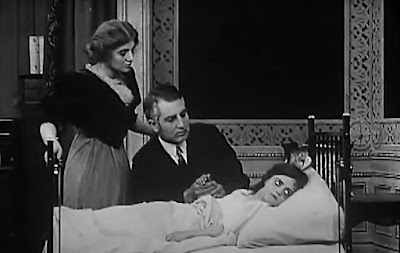Starring: Herbert Yost, Linda Arvidson, Arthur V. Johnson, David Miles, and Anita Hendrie
Director: D.W. Griffith
Rating: Seven of Ten Stars
Writer Edgar Allan Poe (Yost) is struggling to make enough money to purchase the food and medicine needed by his ailing wife (Arvidson). Can he find a publisher for his latest peom before it is too late?
"Edgar Allen Poe" is a fictionalized version of the circumstances surrounding the creation and publication of Edgar Allan Poe's most famous work, "The Raven". It condenses several key events in Poe's life to make them occur simultaneously, but what it lacks in historical accuracy it makes up for with heightened drama and tragedy.
One mildly amusing fact about the film is that Poe's name is misspelled in the title--no, for once I did not make a typo in the heading, the film is actually titled "Edgar Allen Poe". This error is typically explained by the fact that the film was rushed to market in order to capitalize on the centennial anniversary of Poe's birth (he was born in Feburary 8, 1809, and the film began playing in theatres on Feburary 8, 1909), having been filmed over two days in January of 1909. By the time the error was noticed, copies of the film had already been made and were shipping out to movie theaters.
This film is far superior to what it's rushed production schedule might seem to infer. It is another innovative entry in Griffith's unfolding invention of much of what remains technical standards in filmmaking today--in this specific case, it was how Griffith lit the scenes.
Whether you have an interested in Edgar Allan Poe, silent movies, or just well-made dramas, I think you might find the few minutes it takes to watch this film. Click below and sit back.
_as_Edgar_Allan_Poe_in_1909_Biograph_film.jpg)






















.jpg)







.jpg)
